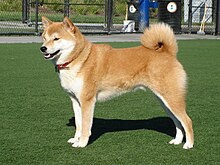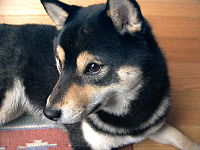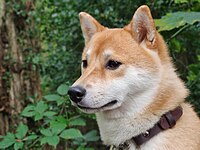Shiba Inu
| Shiba Inu | |||||||||||||||||||||||||||||
|---|---|---|---|---|---|---|---|---|---|---|---|---|---|---|---|---|---|---|---|---|---|---|---|---|---|---|---|---|---|
 A three year old Red Shiba Inu | |||||||||||||||||||||||||||||
| Other names |
| ||||||||||||||||||||||||||||
| Origin | Japan | ||||||||||||||||||||||||||||
| |||||||||||||||||||||||||||||
| |||||||||||||||||||||||||||||
| Dog (domestic dog) | |||||||||||||||||||||||||||||
| Shiba Inu | |||||
|---|---|---|---|---|---|
"Shiba Inu" in kanji | |||||
| Japanese name | |||||
| Kanji | 柴犬 | ||||
| Kana | しば いぬ | ||||
| |||||
The Shiba Inu (柴犬, Shiba Inu, Japanese: [ɕiba inɯ]) is a breed of hunting dog from Japan. A small-to-medium breed, it is the smallest of the six original dog breeds native to Japan.[1] Its name literally translates to "brushwood dog", as it is used to flush game.
A small, alert, and agile dog that copes very well with mountainous terrain and hiking trails, the Shiba Inu was originally bred for hunting.[1][2] It looks similar to other Japanese dog breeds such as the Akita Inu or Hokkaido, but the Shiba Inu is a different breed with a distinct bloodline, temperament, and smaller size than other Japanese dog breeds.[3][4]
Appearance
[edit]The Shiba's body frame is compact with well-developed muscles.[5] It is double-coated, with the outer coat being stiff and straight and the undercoat soft and thick. Fur is short and even on the foxlike face, ears, and legs. Guard hairs stand off the body and are about 4 to 5 cm (1+1⁄2 to 2 in) long at the withers. The purpose of the guard hairs is to protect their underlying skin and to repel rain or snow. The tail hair is slightly longer and stands open in a brush.[6] Their tails are a defining characteristic and make them stand apart from other dog breeds.
The cream color is considered a "major fault" by both the Japan Kennel Club and American Kennel Club.[6] It should never be intentionally bred in a show dog, as the required markings known as "urajiro" (裏白) are not visible; "Urajiro" literally translates to "underside white".[2] Conversely, a white (cream) coat is perfectly acceptable according to the British Kennel Club breed standard.[7]
The urajiro (cream to white ventral color) is required in the following areas on all coat colors: on the sides of the muzzle, on the cheeks, inside the ears, on the underjaw and upper throat inside of legs, on the abdomen, around the vent and the ventral side of the tail. On reds: commonly on the throat, fore chest, and chest. On blacks and sesames: commonly as a triangular mark on both sides of the fore chest.[8]
-
A "white" (also called "cream") Shiba Inu
-
A sesame Shiba Inu
-
A black and tan Shiba Inu with urajiro
-
A red Shiba Inu with visible urajiro on the muzzle, cheeks, ears and throat
Temperament
[edit]
The Shiba Inu is considered an alert, affectionate, and independent breed with high intelligence but also somewhat stubborn and strong-willed.[9]
The terms "spirited boldness" (悍威, kan'i), "good nature" (良性, ryōsei), and "artlessness" (素朴, soboku) have subtle interpretations that have been the subject of much commentary.[10]
A survey of experts classified the Shiba Inu as having 'high aggression, high reactivity and medium trainability'.[11] A possible explanation for this and other observed behaviour is that the Shiba Inu is more closely related to the wolf than domesticated dogs from other countries.[12] Due to the high intelligence of the breed it requires a lot of exercise and stimulation. Insufficient exercise can lead to anxiety which leads to undesirable behaviours, notably the 'shiba scream'.[9][13]
A survey in Japan found the Shiba Inu to be more likely to engage in destructive behaviour, refusal to walk whilst on a lead, engage in mounting behaviour, and tail chasing. The Shiba Inu was also found to be less likely to bark at noises whilst inside the house.[14]
History
[edit]
The Shiba Inu has been identified as a basal breed that predates the emergence of the modern breeds in the 19th century.[15] Dogs with a similar appearance to the Shiba Inu were represented in dogū made during the prehistoric Jōmon period of Japanese history.[16]
The Shiba Inu was bred to hunt and flush small game, such as birds and rabbits. Shiba lived in the mountainous areas of the Chūbu region. During the Meiji Restoration, western dog breeds were imported and crosses between these and native Japanese breeds became popular. From 1912 to 1926, almost no pure Shiba remained. From around 1928, hunters and intellectuals began to show interest in the protection of the remaining pure Shiba.[17]
Despite efforts to preserve the breed, the Shiba nearly became extinct during World War II[5] due to wartime food shortage, as well as outbreaks of distemper in the 1950s and 60s and the Great Tottori Fire, which discouraged preservation efforts. [18][19] [1] All subsequent dogs were bred from the only three surviving bloodlines.[20] These bloodlines were the Shinshu Shiba from Nagano Prefecture, the Mino Shiba from the former Mino Province in the south of present-day Gifu Prefecture, and the San'in Shiba from Tottori and Shimane Prefectures.[21]
The Shinshu Shibas possessed a solid undercoat, with a dense layer of guard hairs, and were small and red in color. The Mino Shibas tended to have thick, prick ears, and possessed a sickle tail, rather than the common curled tail found on most modern Shibas. The San'in Shibas were larger than most modern shibas, and tended to be black, without the common tan and white accents found on modern black-and-tan shibas.[21]
When the study of Japanese dogs was formalized in the early and mid-20th century, these three strains were combined into one overall breed, the Shiba Inu.[21] The first Japanese breed standard for the Shiba, the Nippo Standard, was published in 1934. In December 1936, the Shiba Inu was recognized as a Natural Monument of Japan through the Cultural Properties Act, largely due to the efforts of Nippo (Nihon Ken Hozonkai), the Association for the Preservation of the Japanese Dog.[21][22]
In 1954, an armed service family brought the first Shiba Inu to the United States.[20] In 1979, the first recorded litter was born in the United States.[20] The Shiba was recognized by the American Kennel Club in 1992 and added to the AKC Non-Sporting Group in 1993.[1][23] It is now primarily kept as a pet both in Japan and abroad.[24] According to the American Kennel Club, the Shiba Inu is the number one companion dog in Japan. In the United States the breed ranked 44th place in registrations for 2016 with the American Kennel Club.[25]
Health
[edit]
A study in Japan on patella luxation in small breeds found the Shiba Inu to have the second highest rate of the condition, with 35% of the Shiba Inus surveyed being affected.[26] Three genes belonging to the breed were associated with glaucoma were found in an analysis of DNA sequencing.[27] Another study from Japan reviewing cases of dogs presented for ophthalmologic examination found the Shiba Inu to make up 33% of all glaucoma cases whilst only making up 2.7% of the total population used in the study.[28] Pyometra, a uterine infection of intact bitches, is slightly more common in the Shiba Inu.[29][30] The Shiba Inu is predisposed to canine atopic dermatitis.[31][32][33] An auto-immune disease common in Akitas Vogt-Koyanagi-Harada-like syndrome is known to occur in the Shiba Inu.[34]
Lifespan
[edit]A review of cemetery data in Japan found that the Shiba Inu had a life expectancy of 15 and a half years, greater than any other breed.[35] A 2024 UK study found a life expectancy of 14.6 years for the breed compared to an average of 12.7 for purebreeds and 12 for crossbreeds.[36]
Sanin Shiba Inu
[edit]The Sanin Shiba Inu is a variety of Shiba Inu.[37]
The Sanin Shiba Inu comes from the Inaba Inu of Tottori Prefecture and the Sekishu Inu of Shimane Prefecture, and both are endangered due to the increase of western dogs. In the early Showa period, Masumi Ozaki, a former landowner in Tottori prefecture, started preservation breeding to prevent the loss of local breeds.[38]
However, as World War II grew more intense, the breeding projects became difficult to maintain. Due to the use of dogs for fur by the military, the number of dogs decreased from 50 to 20. In 1947, the two breeds were bred together to create the foundation stock of the Sanin Shiba Inu. The numbers were still low but the dogs were protected by the Ozaki family, who carried on the preservation activities.[18]
Despite the end of the war, more threats to the breeds emerged in the 1950s and 60s, two outbreaks of distemper occurred in Tottori prefecture, killing many dogs. In addition, the Great Tottori Fire discouraged preservation efforts even more.[19]
In popular culture
[edit]
Despite not being a popular dog breed outside of Japan, the Shiba Inu has become popular on the Internet. Doge is an Internet meme from originally from 2013 characterized by Kabosu, a Shiba Inu, and broken English. A cryptocurrency, Dogecoin, is named after this meme and its logo bears an image of Kabosu. Another cryptocurrency is also named Shiba Inu after the breed. Another Shiba Inu dog that went viral was a dog known as 'Cheems'. He went viral during the COVID-19 pandemic and gained worldwide attention. Cheems died during cancer surgery on August 18, 2023 at the age of 12½ years.[39]
The breed is often referred to as Shibe in memes. According to Jamie Cohen, an assistant professor of media studies at Queens College of the City University of New York, the Shiba Inu breed has had a significant presence in online culture since at least 2010.[40]
See also
[edit]References
[edit]- ^ a b c d "Dog Owners Guide: Shiba Inu". Archived from the original on September 28, 2020. Retrieved August 20, 2007.
- ^ a b "Shiba Inu Breed Standard". American Kennel Club. Archived from the original on February 14, 2015. Retrieved August 20, 2007.
- ^ "Japanese Kennel Club Classification". Jkc.or.jp. Archived from the original on 26 October 2016. Retrieved 1 July 2014.
- ^ "Shiba inu". Japanesedog.org. Archived from the original on 26 July 2014. Retrieved 1 July 2014.
- ^ a b "Get to Know the Shiba Inu" Archived 2015-07-22 at the Wayback Machine, 'The American Kennel Club', retrieved 14 May 2014
- ^ a b "柴" [Shiba] (in Japanese). Japan Kennel Club. February 27, 2019. Archived from the original on August 9, 2020. Retrieved September 11, 2020.
- ^ "Japanese Shiba Inu Breed Standard". The Kennel Club Limited. Archived from the original on October 28, 2012. Retrieved November 16, 2012.
- ^ "NSCA: Urajiro". Archived from the original on September 20, 2007. Retrieved August 23, 2007.
- ^ a b Johnstone, Gemma. "Shiba Inu". The Spruce Pets. Retrieved 26 January 2024.
- ^ Miriam Clews (Ed.). The Japanese Shiba Inu: A detailed study of the Shiba.
- ^ TAKEUCHI, Yukari; MORI, Yuji (2006). "A Comparison of the Behavioral Profiles of Purebred Dogs in Japan to Profiles of those in the United States and the United Kingdom". Journal of Veterinary Medical Science. 68 (8). Japanese Society of Veterinary Science: 789–796. doi:10.1292/jvms.68.789. ISSN 0916-7250. PMID 16953077.
- ^ Parker, Heidi G.; Kim, Lisa V.; Sutter, Nathan B.; Carlson, Scott; Lorentzen, Travis D.; Malek, Tiffany B.; Johnson, Gary S.; DeFrance, Hawkins B.; Ostrander, Elaine A.; Kruglyak, Leonid (2004-05-21). "Genetic Structure of the Purebred Domestic Dog". Science. 304 (5674). American Association for the Advancement of Science (AAAS): 1160–1164. Bibcode:2004Sci...304.1160P. doi:10.1126/science.1097406. ISSN 0036-8075. PMID 15155949.
- ^ Fassbaugh, Emily A. "Shiba Inu". PetMD. Retrieved 26 January 2024.
- ^ YAMADA, Ryoko; KUZE-ARATA, Sayaka; KIYOKAWA, Yasushi; TAKEUCHI, Yukari (2019). "Prevalence of 25 canine behavioral problems and relevant factors of each behavior in Japan". Journal of Veterinary Medical Science. 81 (8). Japanese Society of Veterinary Science: 1090–1096. doi:10.1292/jvms.18-0705. ISSN 0916-7250. PMC 6715928. PMID 31167977.
- ^ Larson, G (2012). "Rethinking dog domestication by integrating genetics, archeology, and biogeography". Proc. Natl. Acad. Sci. U.S.A. 109 (23): 8878–83. Bibcode:2012PNAS..109.8878L. doi:10.1073/pnas.1203005109. PMC 3384140. PMID 22615366.
- ^ "世界初!犬種豆柴の血統書を発行!" [World's First! The creation of a pedigree for Mameshiba!] (in Japanese). Japan Kennel Club. 2004. Archived from the original on 1 July 2020. Retrieved 23 April 2021.
- ^ "世界の犬 : 5G 原始的な犬・スピッツ : し : 柴 – SHIBA" [World dogs: 5G primitive dog · Spitz: Shi: Shiba – SHIBA]. jkc.or.jp (in Japanese). Archived from the original on May 16, 2018. Retrieved May 16, 2018.
- ^ a b ""Sanin Shiba Inu" protects and conveys Tottori, overcoming the crisis". sankei (in Japanese). 2019-12-28. Retrieved 2023-07-27.
- ^ a b "Cuteness spreads in the blink of an eye, Sanin Shiba Inu, overcoming the crisis and becoming popular". asahi (in Japanese). 2021-02-13. Retrieved 2023-07-27.
- ^ a b c "Shiba Inu Dog Breeds". 5stardog.com. Archived from the original on April 2, 2015. Retrieved August 20, 2007.
- ^ a b c d Haskett, Gretchen; Houser, Susan (1997). The Total Shiba. Loveland, CO: Alpine Publications. ISBN 1-57779-049-9.
- ^ Atkinson, Maureen (1998). The Complete Shiba Inu. Howell Book House. p. 11. ISBN 0-87605-177-8.
- ^ "Shiba Inu Dog Breed Information". AKC.org. American Kennel Club. Archived from the original on November 12, 2020. Retrieved November 13, 2020.
- ^ Holden, Jacey. "Shiba Inus". k9web.com. Archived from the original on August 12, 2007. Retrieved August 23, 2007.
- ^ "Dog Registration Statistics Historical Comparisons & Notable Trends". AKC.org. American Kennel Club. 2013. Archived from the original on 17 January 2017. Retrieved 17 February 2018.
- ^ MAEDA, Kazuhiro; INOUE, Mai; TANAKA, Miho; MOMOZAWA, Yukihide (2019). "Evidence of genetic contribution to patellar luxation in Toy Poodle puppies". Journal of Veterinary Medical Science. 81 (4). Japanese Society of Veterinary Science: 532–537. doi:10.1292/jvms.18-0485. ISSN 0916-7250. PMC 6483903. PMID 30745525.
- ^ Kanemaki, Nobuyuki; Tchedre, Kissaou T.; Imayasu, Masaki; Kawarai, Shinpei; Sakaguchi, Masahiro; Yoshino, Atsushi; Itoh, Norihiko; Meguro, Akira; Mizuki, Nobuhisa (2013-09-11). "Dogs and Humans Share a Common Susceptibility Gene SRBD1 for Glaucoma Risk". PLOS ONE. 8 (9). Public Library of Science (PLoS): e74372. Bibcode:2013PLoSO...874372K. doi:10.1371/journal.pone.0074372. ISSN 1932-6203. PMC 3770690. PMID 24040232.
- ^ KATO, Kumiko; SASAKI, Nobuo; MATSUNAGA, Satoru; NISHIMURA, Ryohei; OGAWA, Hiroyuki (2006). "Incidence of Canine Glaucoma with Goniodysplasia in Japan: A Retrospective Study". Journal of Veterinary Medical Science. 68 (8). Japanese Society of Veterinary Science: 853–858. doi:10.1292/jvms.68.853. ISSN 0916-7250. PMID 16953087.
- ^ "Shiba Inu". Animal Health Clinic. Archived from the original on 26 January 2024. Retrieved 26 January 2024.
- ^ "Shiba Inu". Jolly Road Veterinary Hospital. Retrieved 26 January 2024.
- ^ TANAKA, Kazuaki; YAMAMOTO-FUKUDA, Misaki; TAKIZAWA, Tatsuya; SHIMAKURA, Hidekatsu; SAKAGUCHI, Masahiro (2020). "Association analysis of non-synonymous polymorphisms of interleukin-4 receptor-α and interleukin-13 genes in canine atopic dermatitis". Journal of Veterinary Medical Science. 82 (9). Japanese Society of Veterinary Science: 1253–1259. doi:10.1292/jvms.20-0301. ISSN 0916-7250. PMC 7538314. PMID 32669513.
- ^ Fujimura, M.; Ishimaru, H.; Nakatsuji, Y. (2014-06-01). "Fluoxetine (SSRI) treatment of canine atopic dermatitis: a randomized, double-blind, placebo-controlled, crossover trial". Polish Journal of Veterinary Sciences. 17 (2). Polish Academy of Sciences Chancellery: 371–373. doi:10.2478/pjvs-2014-0053. ISSN 2300-2557. PMID 24988868.
- ^ Wood, Shona Hiedi; Ke, Xiayi; Nuttall, Tim; McEwan, Neil; Ollier, William E.; Carter, Stuart D. (2009). "Genome-wide association analysis of canine atopic dermatitis and identification of disease related SNPs". Immunogenetics. 61 (11–12). Springer Science and Business Media LLC: 765–772. doi:10.1007/s00251-009-0402-y. ISSN 0093-7711. PMID 19838693.
- ^ "The detail information of Vogt-Koyanagi-Harada-like syndrome". China National Center for Bioinformation. Retrieved 26 January 2024.
- ^ Inoue, Mai; C. L. Kwan, Nigel; Sugiura, Katsuaki (24 May 2018). "Estimating the life expectancy of companion dogs in Japan using pet cemetery data". J Vet Med Sci. 80(7), 2018 July (7): 1153–1158. doi:10.1292/jvms.17-0384. PMC 6068313. PMID 29798968.
- ^ McMillan, Kirsten M.; Bielby, Jon; Williams, Carys L.; Upjohn, Melissa M.; Casey, Rachel A.; Christley, Robert M. (2024-02-01). "Longevity of companion dog breeds: those at risk from early death". Scientific Reports. 14 (1). Springer Science and Business Media LLC: 531. Bibcode:2024NatSR..14..531M. doi:10.1038/s41598-023-50458-w. ISSN 2045-2322. PMC 10834484. PMID 38302530.
- ^ Maki, Takuya; Inoue-Murayama, Miho; Hong, Kyung-Won; Inoue, Eiji; Maejima, Masami; Kansaku, Norio; Tanabe, Yuichi; Ito, Shin'ichi (2008). "Genetic Diversity and Relationship among Three Varieties of the Shiba Inu Revealed by Microsatellite Markers". The Journal of Animal Genetics. 36 (2): 95–104. doi:10.5924/abgri2000.36.95. ISSN 1884-3883.
- ^ "Pinned ears, shining eyes ... "Sanin Shiba Inu" running with cheeks, mellow with cuteness". yomiuri (in Japanese). 2019-09-19. Retrieved 2023-07-27.
- ^ "Famous Meme Dog Cheems Dead at 12". TMZ. 19 August 2023. Retrieved 4 January 2024.
- ^ Thorsberg, Christian (2022-08-06). "Good doge: How the internet adopted the Shiba Inu and gave it a forever home". Grid News. Archived from the original on 2022-09-04. Retrieved 2022-08-30.




